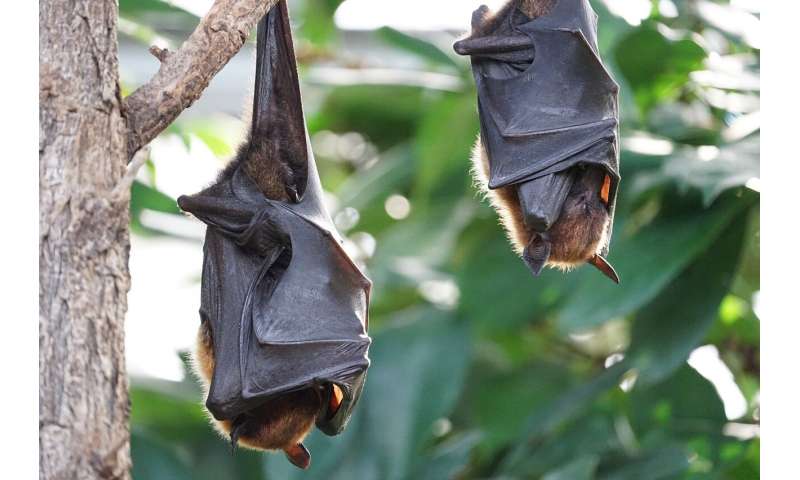
While the exact origin of the coronavirus remains murky, scientists have been racing to determine how it jumped from animals to humans so they can prevent another pandemic.
The next one could just be a matter of time, a study published recently suggests.
The authors said a virus with similar ability to infect humans may already be out there, carried by a type of bats known for having horseshoe-shaped “leafs” on their noses.
Scientists made that prediction after constructing a family tree of the coronavirus—tracing its ancestry by comparing its genetic code with that of other coronaviruses found in bats, humans, and a scaly animal called the pangolin.
The lineage of the virus that causes COVID-19 appears to have branched off from its closest viral relatives about 40 to 70 years ago, the authors wrote in Nature Microbiology. And other viruses in the same branch of the family likely share a similar ability to latch onto cells in human airways, said Maciej F. Boni, a Pennsylvania State University biologist and lead study author.
“It’s very likely there are lots of other lineages that nobody knows about, because nobody has sampled, that are circulating quietly in bats,” he said. “Potentially all of them could have this ability to infect human cells.”
Tracing the family trees of viruses is a challenge, as the microbes mutate and swap sections of their genomes in ways that make it difficult to tell what happened when.
Coronaviruses, in particular, are prone to this type of recombination, in part because a bat can carry several types at once. A virus inside a bat can easily pick up bits of genetic code from other viruses infecting the same animal—say, grabbing the instructions for latching onto human cells from one source, while picking up the code to penetrate cell membranes from another.
Yet by using a battery of statistical techniques, the scientists identified three genetic regions in the coronavirus that appeared to have remained intact for decades. They identified the same three regions in another coronavirus that came from a bat found in Yunnan, a province in southern China near Laos.
That virus cannot infect humans but is otherwise highly similar to the one causing the pandemic, which was first identified in human patients in the city of Wuhan. The two viruses seem to have branched apart in the family tree sometime in the 1960s, and almost certainly have undiscovered cousins with the potential to infect humans, said Boni, who collaborated with scientists in Europe and China.
The research represents a valuable advance in tracing the origin of the coronavirus responsible for COVID-19, said Alina Chan, a molecular biologist at the Broad Institute in Cambridge, Mass., who was not involved in the study.
“They’ve narrowed it down,” she said.
A good way to hunt for cousins of these two coronaviruses would be to take samples from bats along the hundreds of miles separating Yunnan and Wuhan, said Boni, a member of Penn State’s Center for Infectious Disease Dynamics. That could guide strategies to prevent such viruses from “jumping” from bat to humans in the future, perhaps by identifying live animal markets where better hygiene measures could be implemented.
The coronavirus responsible for COVID-19 was originally thought to have jumped from animal to human at such a market in Wuhan, but Chinese officials later discounted that possibility, as some of the first patients had no apparent connection to that market. Scientists have since speculated that the fateful transmission occurred at some other market. U.S. intelligence officials have suggested that it may have been accidentally released at a research lab, but virologists in academia are generally skeptical of that theory.
By itself, the presence of similar coronaviruses in bats would not mean another pandemic is imminent, said Kevin Olival, vice president for research at EcoHealth Alliance, a nonprofit that works with scientists worldwide to protect people and animals from infectious disease.
The size and range of the relevant bat population and the behavior of humans also are part of the equation.
“To calculate the risk, you’ve got to put all those pieces together,” he said.
Among the countries where the nonprofit has worked with local scientists to sample bat populations is China, though U.S. funding for that collaboration was put on hold by the Trump administration, with officials citing the virus-released-from-a-Chinese-lab theory. More than 70 Nobel laureates denounced the move.
What is not in dispute is that viruses have been jumping from animals to humans for centuries, and that it will happen again.
And coronaviruses carried by bats are a prime suspect.
Similar predictions have been made before—such as in 2013, when a Science magazine article was headlined “Bats May Be Carrying the Next SARS Pandemic.”
Source: Read Full Article